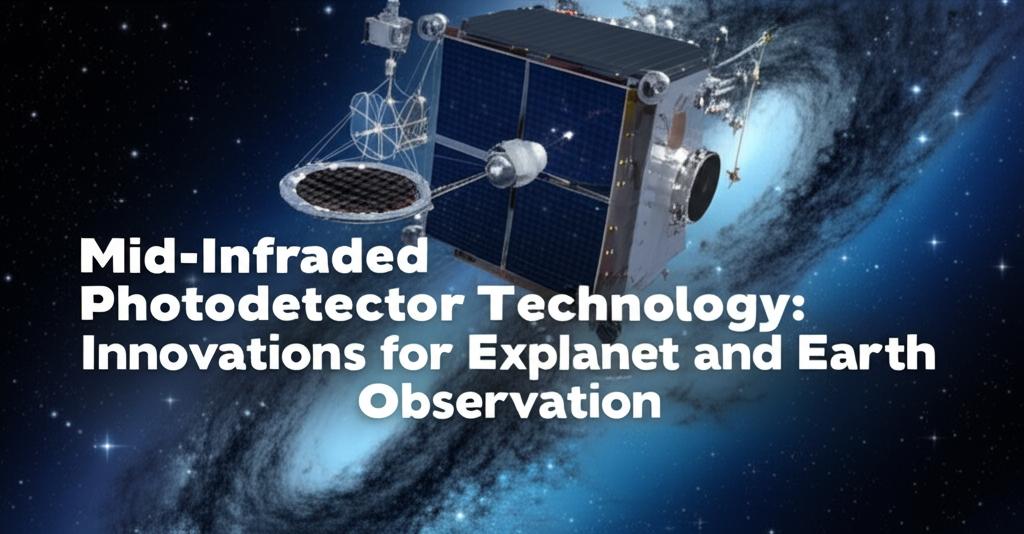Mid-infrared (MIR) photodetector technology is rapidly advancing, with significant implications for both exoplanet research and Earth observation. These innovations focus on improving sensitivity, operational range, and practicality, enabling new discoveries in space and more effective monitoring of our own planet.
Key Innovations and Their Impact:- Room-Temperature Operation and CMOS Compatibility: A major breakthrough is the development of MIR photodetectors that can operate stably at room temperature. Traditionally, MIR detectors required cryogenic cooling to reduce thermal noise, which increased their size, cost, and complexity, limiting their use in portable or compact systems.
Researchers at the Korea Advanced Institute of Science and Technology (KAIST) have recently developed a MIR photodetector using germanium (Ge) that operates at room temperature and is compatible with conventional silicon-based CMOS (complementary metal-oxide-semiconductor) manufacturing processes. This is a significant step towards low-cost mass production of ultra-compact optical sensors.
This new type of photodetector often utilizes the bolometric effect, where absorbed light causes a temperature increase that in turn changes electrical signals. This allows for the detection of a broad MIR spectral range.
The ability to operate at room temperature and integrate with CMOS technology opens doors for widespread applications, including environmental monitoring (like real-time CO2 detection), medical diagnostics, industrial process management, and smart devices.
- Enhanced Sensitivity for Faint Signals: Detecting exoplanets and analyzing their atmospheres, as well as observing subtle environmental changes on Earth, requires highly sensitive photodetectors capable of measuring extremely weak light intensities.
NASA's James Webb Space Telescope (JWST) exemplifies the power of MIR spectroscopy in analyzing molecular components like water vapor and sulfur dioxide in exoplanet atmospheres. Each molecule has a unique spectral "fingerprint" in the MIR range.
New detector technologies, such as avalanche photodiode arrays, are being developed to meet these stringent sensitivity requirements. These sensors can multiply the signal from a single photon, significantly boosting detection capabilities for faint signals from distant exoplanets.
Superconducting nanowire single-photon detectors (SNSPDs) are another promising avenue, offering high detection efficiency, low dark count rates, and fast response times, crucial for applications like exoplanet transit spectroscopy.
- Broader Spectral Range: Innovations are expanding the range of MIR wavelengths that can be detected.
Detectors leveraging the bolometric effect can cover the entire MIR spectral range, enabling the real-time sensing of various molecular species. This is crucial for identifying a wider array of atmospheric components on exoplanets and for comprehensive environmental analysis on Earth.
- Miniaturization and Integration: The development of waveguide-integrated photodetectors allows for the fusion of photodetection and optical waveguides on a single chip. This leads to more advanced optical circuits, enhanced performance, and reduced system complexity. Such miniaturization is vital for deploying sensors on satellites, drones, and portable field instruments.
- New Materials: Research into novel semiconductor materials is paving the way for next-generation MIR detectors.
Quantum dot infrared photodetectors (QDIPs) offer the potential for improved sensitivity, reduced dark current (noise), and multicolor detection.
Graphene and other two-dimensional materials are being explored for their high carrier mobility and tunable electronic properties, which could lead to high-performance MIR detectors with lower cooling requirements.
Materials like indium arsenide antimonide (InAsSb) are being integrated onto silicon wafers, enabling high-quality crystalline layers for MIR light-emitting diodes (LEDs) and detectors.
Applications in Exoplanet Research:- Atmospheric Characterization: MIR photodetectors are essential for detecting and measuring the spectral signatures of gases, including potential biosignatures, in the atmospheres of exoplanets as they transit their host stars.
- Direct Imaging: Ultra-low-noise infrared detectors are critical for the direct imaging of exoplanets, which appear incredibly faint and close to their bright host stars.
- Environmental Monitoring: Room-temperature, compact MIR sensors can be deployed for real-time monitoring of greenhouse gases (like CO2), pollutants, and other atmospheric components. This is vital for climate change studies and air quality assessment.
- Precision Agriculture and Resource Management: MIR sensing can provide valuable information about soil composition, crop health, and water resources.
- Hazardous Gas Detection: The ability to detect various molecular species makes these sensors suitable for identifying and monitoring hazardous gases in industrial settings or public spaces.
- Lidar Systems: Mid-infrared Frequency-Modulated Continuous Wave (FMCW) lidar, using laser light, can create detailed 3D maps of the environment, even in adverse conditions like fog or dust. This has applications in autonomous navigation for drones and improved Earth observation from satellites.
The field continues to evolve, with ongoing efforts to further improve detector performance, reduce costs, and expand the range of applications. The integration of artificial intelligence (AI) with advanced sensor data is also expected to unlock new analytical capabilities. The development of next-generation space telescopes and Earth observation satellites will heavily rely on these cutting-edge mid-infrared photodetector technologies. Projects like the INPHOMIR project, funded by the European Union, aim to develop ultra-low-power compact sensing devices like optical gyroscopes and MIR lidar to enhance satellite navigation and Earth observation capabilities.

